Daffodil The March Birth Flower
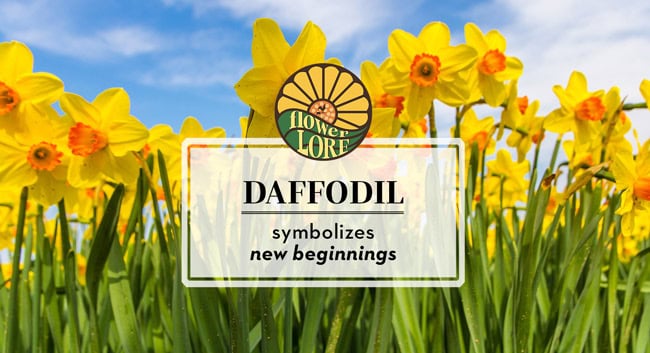
Often one of the earliest blooms to brighten spring landscapes, it is no surprise that the daffodil is honored as the March birth flower as spring begins with the vernal equinox. But what makes these cheerful flowers even more engaging and symbolic for the month of March? The more you know about daffodils, the better you will appreciate their folklore, symbolism, and connection to the month.
Jump to Daffodil Meaning Around the World
About Daffodils
Daffodils are spring-flowering perennial bulbs that belong to the amaryllis family, Amaryllidaceae. Depending on how individual flowers are classified, there are as few as 30 to more than 150 individual species of daffodils, with thousands of cultivars and hybrid types available.
These flowers are instantly recognizable even by novice gardeners because of their distinctive cup- or trumpet-like center with ruffled edges surrounded by six outer petals. Just one or two blooms are most common for each stalk, though some varieties have even more.
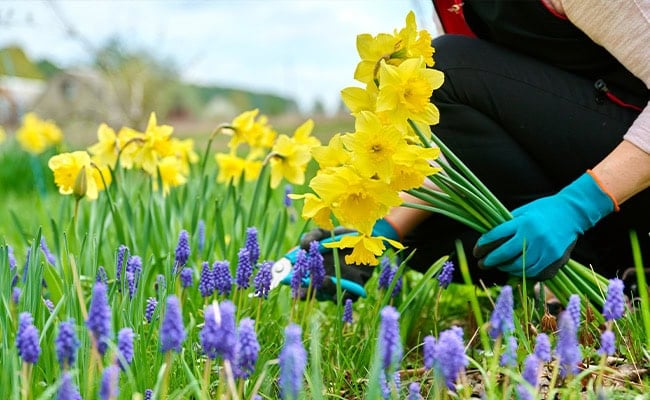
Bright, sunny, lemon, or butter yellow is the classic daffodil color, but these blooms can be found in different yellow shades as well as white, pale yellow-green, or orange, with many daffodil types showing more than one color as highlights or accents. The green foliage is typically thin and strand- or blade-like, though the leaf thickness varies for different daffodil varieties.
Native to the Iberian peninsula and Mediterranean region of southwestern Europe, natural daffodils sprout prolifically in meadows, woodlands, and marshes, as well as on rocky hillsides and similar habitats. Today, modern cultivars and landscaping have made these flowers popular in gardens, yards, parks, and containers worldwide.
Daffodil Symbolism
Also called the daffadown dilly, Lent lily, or Easter bell, daffodils have obvious connections to spring and Easter with a sense of rebirth and renewal. Two other plants, jonquils and paperwhite narcissus, are individual types of daffodils—the term “daffodil” is used as a common, familiar name for all these flowers.
The scientific name, Narcissus, comes from the Greek word narkissos which is related to the concept of pleasant numbness. While often associated with the Greek myth of the hunter Narcissus, there is no known evidence that the plant was actually named after the Greek character.
In modern times, however, the Greek legend of Narcissus has become intimately associated with these flowers. According to the myth, the hunter Narcissus was so vain and self-involved that when he saw his reflection in a pool of water, he was so besotted that he refused to leave, eventually falling into the water and drowning (though different versions have different variations of his depth). Flowers—narcissus or daffodil blooms—sprouted where he died. Because some varieties of these blooms have pendulate heads, nodding as if watching their reflections in water, they can represent that character’s obsession with himself.
Daffodil Meaning Around The World
Many Western cultures associate daffodils with vanity or self-obsession, and these flowers have several other negative associations as well. One superstition associates white daffodils with death, and they are occasionally called “grave flowers” to represent that connection. In ancient Greece, these flowers were often planted alongside tombs.
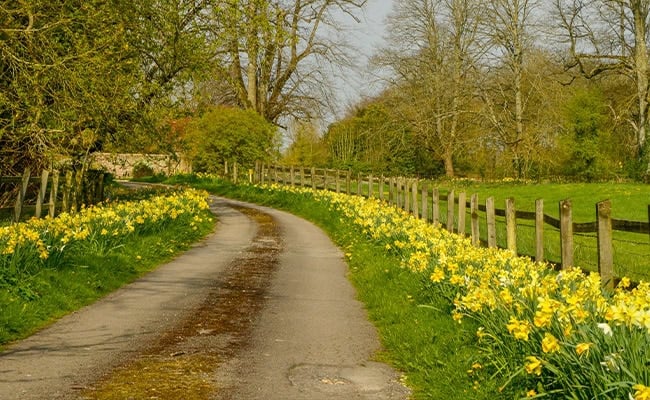
In fact, another Grecian myth connects narcissus blooms or daffodils directly with the underworld. When the Greek goddess of spring, Persephone, was picking flowers, she was reaching for a daffodil when Hades abducted her and stole her away to his domain, where she would eventually become his wife and queen. In this way, daffodils have occasionally been associated with a one-sided or unrequited love, and a single daffodil is associated with bad luck omens.
On a happier note, these flowers can also represent a one-and-only love, and in the language of flowers—floriography—daffodils symbolize new beginnings, joy, eagerness, enthusiasm, friendship, cheer, thanks, and “get well” wishes.
Overall, daffodils have far more positive associations than negative ones. In Eastern cultures, these blooms represent wealth and good fortune, with cut daffodils in a vase often thought to bring abundance into a home. With their appearance early in spring, these flowers are also seen as a symbol of rebirth and new beginnings. In Iranian culture, daffodils are popular for Nowruz, the Persian new year, and similarly, in Chinese culture, these are a good luck flower for the new year.
The Daffodil Flower in Art and Literature
These easily-recognized blooms have appeared in art and literature for centuries, including being part of unearthed frescoes in Pompeii as well as pictured in ancient Egyptian tombs. In Persian literature, narcissus represents beautiful eyes, and these flowers have been referenced by some of the world’s most notable authors and poets, including Sophocles, Plutarch, Ovid, Homer, Virgil, Stasinos, John Milton, John Keats, and William Shakespeare.
The most well-known literary reference to daffodils is William Wordsworth’s familiar poem “I Wandered Lonely as a Cloud” which describes a field of “golden daffodils” next to a lake. They are “fluttering and dancing in the breeze” with “ten thousand I saw at a glance” – clearly natural beauties that lift the author’s heart long after the blooms have faded.
I wandered lonely as a cloud
That floats on high o’er vales and hills,
When all at once I saw a crowd,
A host, of golden daffodils;
Beside the lake, beneath the trees,
Fluttering and dancing in the breeze.
Continuous as the stars that shine
And twinkle on the milky way,
They stretched in never-ending line
Along the margin of a bay:
Ten thousand saw I at a glance,
Tossing their heads in sprightly dance.
The waves beside them danced; but they
Out-did the sparkling waves in glee:
A poet could not but be gay,
In such a jocund company:
I gazed—and gazed—but little thought
What wealth the show to me had brought:
For oft, when on my couch I lie
In vacant or in pensive mood,
They flash upon that inward eye
Which is the bliss of solitude;
And then my heart with pleasure fills,
And dances with the daffodils.
—William Wordsworth
Daffodil Flower Tips And Warnings
While seeing—and reading about—daffodils may certainly boost your mood, it is important to note that all part of these flowers are toxic. If ingested, they can cause a variety of unpleasant symptoms, including nausea, vomiting, diarrhea, convulsions, and even paralysis. For some individuals, even handling daffodils and getting the flowers’ sap—from cut stems—on their skin can cause reactions such as itching, redness, and hives.
RELATED PRODUCT: Protect your arms with these Garden Sleeves
Daffodil sap is also toxic to other flowers, and will shorten the freshness of other blooms if daffodils are used in a mixed vase of cut flowers. To mitigate that effect, place daffodils in fresh, clean water for 30 minutes (or as long as 24 hours) before mixing them with other blooms. Replacing that water a couple of times while soaking daffodils will also help the toxic sap leach out more quickly.
Ironically, despite their known toxic qualities, daffodils and narcissus have been used for centuries for different medicinal applications. Different parts of the plant—bulbs, stalks, foliage, and blooms—have been used to treat a wide range of ailments, including hair loss, burns, asthma, joint pain, and epilepsy. Daffodils have also been used as a decongestant and an aphrodisiac. Is should be noted, however, that there are no scientific studies validating these flowers for any of these uses.
What modern medical science does validate, however, is that galantamine, an alkaloid present in narcissus, is a treatment for mild to moderate Alzheimer’s dementia, helping to reduce cognitive decline. The sweet aroma of daffodils is also used for relaxation and mood improvement in aromatherapy practices. (Note: Farmers’ Almanac does not advocate using daffodils for medicinal purposes.)
Other than for medicinal uses, daffodils are popularly grown for commercial floriculture, and their essence is a popular component for floral-based perfumes, candles, essential oils, and other scented products.
Growing Daffodil Plants
Whether you are interested in the March birth month flower as a lovely spring bloom, a symbol of a special moment in the month, for its sweet scent, or just because it’s a pretty accent for any garden or landscape, growing daffodils is easy! In fact, these blooms have been widely cultivated since the 1500s, and as they are resistant to deer, rabbits, and squirrels, they are favorites for everyday gardening. Daffodils are beautiful when naturalized in the landscape or used as borders, tree rings, or in flowerbeds to enjoy or to cut for bouquets and arrangements.
Different types of daffodils and narcissus can thrive in zones 3b to 10, depending on their hardiness or their adaptability to heat and humidity. These flowers can be as diminutive as just 2-3 inches tall for dwarf varieties, or up to 30-32 inches in height, with widths from 6-12 inches. Eventually, they will fill in an area, and should be divided every 4-5 years to avoid overcrowding an area.
Related: Do you know your Growing Zone? Find out!
Plant daffodil flower bulbs in rich, well-drained soil that is neutral or slightly acidic (6.5-7 pH), ideally in full sun or dappled shade. Late afternoon shade will be especially important in warmer areas where the sun can be overpowering, though daffodils aren’t often blooming when summer heats up—which is why they are great choices to ring deciduous trees, as the flowers will be a bright spot in the yard before the trees leaf out completely.
In southern areas, narcissus and daffodils are often purchased as pre-chilled bulbs and planted as annuals rather than perennials, since southern climates will not provide the adequate chill time necessary for the next year’s growth.
RELATED: Gardening By The Moon Calendar
The bulbs should be firm with a papery outer layer, and should be planted pointed end up for proper growth. Daffodil bulbs are typically planted 3-6 inches deep, with larger bulbs planted deeper and smaller bulbs only needing shallower depths. These flowers can be planted 5-12 inches apart, but will fill in an area over the years no matter how widely they are spaced if conditions are favorable.
Daffodils like moisture but, as with most bulbs, cannot tolerate soggy or waterlogged soils. If planted in containers, drainage holes are essential. During the summer months, these flowers are dormant and can tolerate drier conditions.
When daffodils fade after their roughly six week bloom cycle, the flowers can be deadheaded so energy is not put in to developing seed pods. The flower’s foliage, however, should be left intact as long as possible so the energy the leaves take in can help nourish and replenish the bulb for the next year.
Daffodil Imposters and Other March Birth Month Flowers
While daffodils are instantly recognizable, there are other flowers that are often confused for these popular blooms—or at least they seem to be confusing. Jonquils and narcissus are other names for daffodils, or more precisely, for specific types of daffodils. Put another way, all jonquils and narcissus are daffodils, but not all daffodils are either jonquils or narcissus. It should be noted that the paperwhite narcissus (Narcissus papyraceus) is the December Birth Flower. While it is indeed a type of daffodil, it is white with only a very small yellow center, unlike the more “classic” all-yellow daffodil with a much more pronounced center.
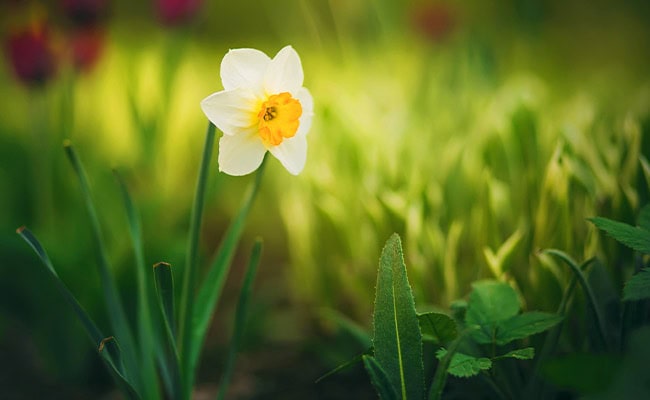
The most common jonquil, on the other hand, is a true species of daffodil (Narcissus jonquilla), that is often cited as an alternative March birth month flower. It is also called the rush daffodil, and is the typical cheery yellow expected of these flowers, making it an iconic choice for the month.
Buttercups are another flower often confused for daffodils, which themselves might casually be called buttercups because of their buttery yellow color and distinctive cup-like centers. In reality, however, the flowers better known as buttercups are actually from an entirely different family (Ranunculaceae) and are a type of ranunculus. These flowers are a cheery yellow and the petals form a cup shape, but they lack the distinct central trumpet of daffodils.
Finally, one other iconic spring flower is sometimes considered the March birth month flower—the cherry blossom. This is particularly prominent in Japanese culture where the cherry blossom, also called the sakura, is one of the national flowers and is highly symbolic for renewal and rebirth, similar to the daffodil.
Daffodils are much more than just pretty flowers. As the March birth flower, these blooms have a great deal of nostalgia and symbolism, and are a fun choice as gifts not only for March birthdays, but for anniversaries, other special occasions, and just because. Their cheerful color and delightful scent makes daffodils a lovely choice for many uses, and their easy-to-grow nature can bring them into even beginner’s gardens and landscapes without difficulty.
Join The Discussion
Which March birth month flower do you prefer?
Did anything surprise you about daffodil meaning or otherwise?
Share your thoughts, tips, and tricks in the comments below!
Related
How To Grow A Birth Flower Garden
RELATED PRODUCT: March Birthstone – Bloodstone Necklace

Melissa Mayntz
Melissa Mayntz is a writer who specializes in birds and birding, though her work spans a wide range—from folklore to healthy living. Her first book, Migration: Exploring the Remarkable Journeys of Birds was published in 2020. Mayntz also writes for National Wildlife Magazine and The Spruce. Find her at MelissaMayntz.com.



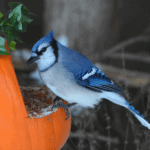
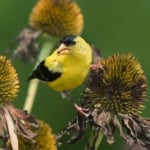
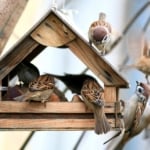
ButterCups
Up here in the Blue Ridge mountains of western NC, the locals refer to daffodils as “Easter lilies” because that’s about when they bloom. No, they don’t mean the white trumpet shaped Asiatic lilies we knew everywhere else, they mean daffodils!
I love daffodils. I was born in March. Never knowing that March flower was
My favorite flower. I planted some. by my sons memorial one year one flower
came up the next two came up. Every
year after that 3 daffodils were there
I love both flowers! I live in the desert near Palm Springs. How can I get those to grow here?
Living in Southern Ontario-probably wont see any daffodils for at least another 6 wks-if not longer. Deep snow all around the house & still snowing today. Not enough warmth on sunny days to melt anything yet….. Have to go buy some potted daffs at the nursery to brighten up the inside. Looking forward to seeing those 1st bulbs popping thru.
I have daffodils all around my yard. Thank you for the information.
Kim, Thanks I am hopeing to get started cleaning the yd tomorrow. Spring has sprung,LOL
Hey I’m going on a cruise on the week of the 25 to the 30th what will the weather be like on the 25th or 24th
joesee, Where is the cruise? We only cover the U.S. and Canada.
Eve, You can clean off your metal arch. In our midwest region, the morning glory grows as an annual and will come back from the seeds that fell to the ground in the fall. It will bloom on the new growth.
I do mean plants.